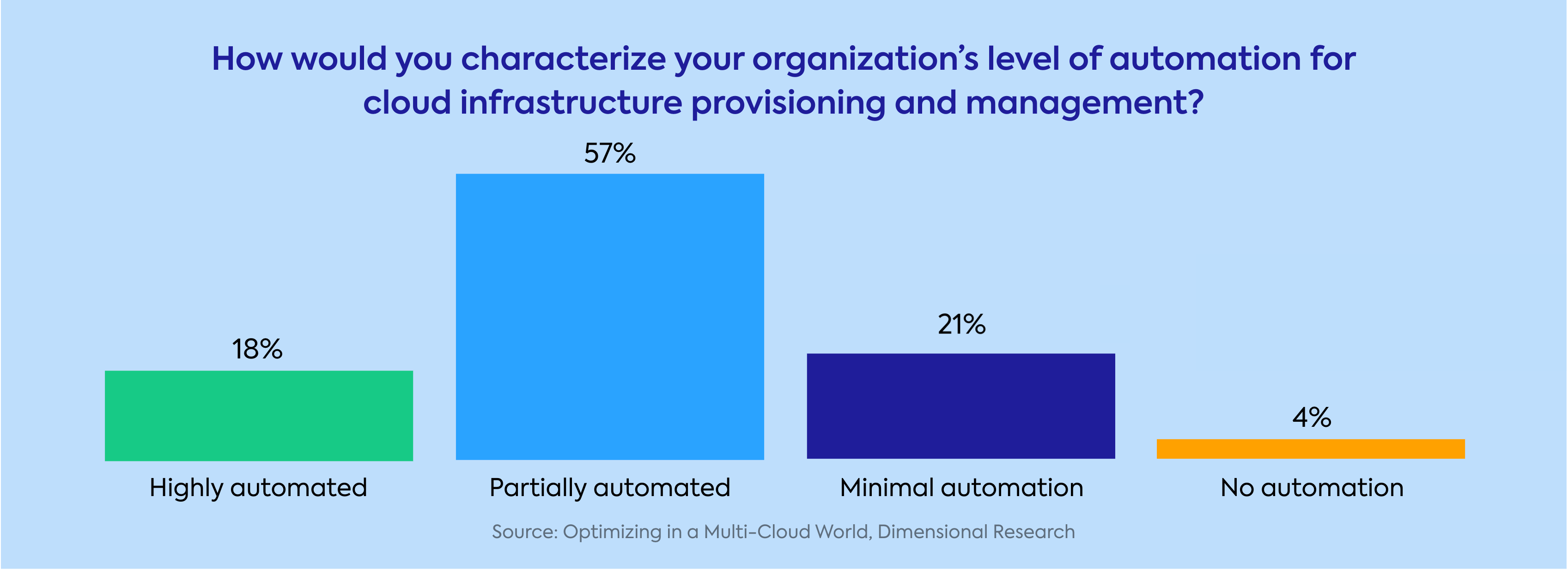
What do today’s cloud practitioners need to navigate the ever-evolving cloud ecosystem? The growing complexity of the cloud requires innovation through automation, optimization, containerization, and a variety of other technologies. Yet with so many different methodologies, strategies, and best practices available to them today, cloud operations professionals need to know which options will bring them the greatest success as their cloud journeys evolve.
Spot wanted to know how CloudOps teams are handling the constant change of the cloud. To get answers, we sponsored a survey, conducted by Dimensional Research, of more than 300 cloud operations professionals at the practitioner level from companies with 100+ employees. The resulting research report also includes feedback from cloud operations stakeholders who participated in a series of in-depth interviews. The primary goal of this study was to capture relevant data on the current state of automation and the optimization of public cloud infrastructures from the perspective of cloud operations practitioners.
Keep reading for highlights from the report’s key findings, and get your copy of the report today.
The 2024 cloud operations environment at a glance
According to our survey, multi-cloud, Kubernetes adoption, and DevOps lead the way. In other words, cloud practitioners are relying on the cloud for more than simple storage and compute, and they need streamlined ways to manage their workloads and operations.
Multi-cloud seems to be the rule rather than the exception these days. Just 26% of respondents said that they only operate in one cloud, whereas 74% use at least two cloud platforms. Additionally, a total of 81% have adopted Kubernetes so far, but only 52% currently have Kubernetes in production.
The survey also asked about the methodologies that respondents’ organizations had adopted or planned to adopt for optimizing their cloud infrastructure. Survey respondents could select multiple answers. By far, DevOps led the way, with 75% adoption so far. The emerging field of platform engineering was also common for 39% of cloud practitioners.
Optimization is a work in progress
While the cloud can be transformative, operating in it is often messy. A staggering 93% of cloud practitioners said that they face challenges in operating cloud infrastructures, with complexity of the cloud environment being the number one concern.
Optimizing cloud performance can help address some of the complexity of the cloud while fine-tuning and improving performance, cost effectiveness, and resource utilization. When asked how often their teams optimize cloud infrastructure resources, only one-third (33%) of respondents described their optimization efforts as continuous. In total, however, 43% optimize on a quarterly basis or less frequently. These findings show that while some are on the right path, most have room for improvement.
Automation delivers benefits that increase with maturity
Automating cloud tasks and processes, using tools and scripts, can streamline cloud operations and cut down on manual intervention. By automating more tasks – continuously and more frequently – organizations can handle running more in the cloud while freeing up staff for more strategic initiatives.
When asked to characterize their organization’s level of automation for cloud infrastructure provisioning and management, the results were mixed. Encouragingly, three-quarters (75%) of respondents say that they are “partially” or “highly” automated in their cloud infrastructure provisioning and management, yet only 18% are “highly” automated. The other quarter of respondents reported minimal or no automation whatsoever.
Cloud infrastructure automation and optimization are considered mainstream and ubiquitous for today’s organizations. But are they seeing tangible business benefits resulting from automating and optimizing their infrastructure? According to the survey, yes. Almost all (96%) of respondents said that they see some kind of positive outcome from their investments in these technologies.
The top benefits included improved system reliability and uptime (64%), cost savings (58%), faster deployment time (56%), and enhanced security and compliance (45%). Respondents also wrote in “other” benefits, such as better integration, flexibility, predictability, and scaling for seasonal demand.
Encouragingly, investments in tools are paying off. The more automation companies have in place, the more likely they are to reap the benefits. Of respondents with “highly automated” environments, 75% reported cost savings. On the other hand, just 47% of those with “minimal” automation reported that they saw reduced cloud costs.
As one platform engineer at a mid-sized financial services firm explained, “I look for opportunities to automate everywhere. It’s my instinct to automate anything I’ve already done once before.”
Cloud operations practitioners are embracing innovation
Just over half (51%) of our survey respondents reported that they have Kubernetes in production. But those who do embrace containerization and K8s are finding a variety of ways to handle the automatic scaling of their Kubernetes workloads, and 92% said they use some method to autoscale these workloads.
Respondents were asked which methods they use and could select more than one option. Of those with Kubernetes in production, over half (54%) use a cluster autoscaler, the most popular method of autoscaling K8s among respondents. Additionally, 48% use application-level (load-based) scaling. Another 44% use horizontal pod scaling, while 36% use vertical pod scaling.
Organizations are also innovating when it comes to optimization with artificial intelligence (AI) and machine learning (ML). More than half (57%) of companies report using AI and ML in their workflows. These technologies are especially well suited for processing large volumes of data and handling complex and unstructured data, such as activity logs.
When asked what role AI or machine learning have in optimizing cloud infrastructure for their organizations, automated anomaly detection was a top choice. Yet AI/ML adoption is still a work in progress, as 43% of respondents said that they don’t see a role for AI/ML in their cloud infrastructure optimization efforts.
Conversely, enterprises that have already invested in commercial tools are more likely to see a role for AI and ML in their companies’ cloud operations. For example, 45% of companies using commercial tools rely on AI and ML to proactively scale resources versus only 22% that haven’t invested in third-party solutions.
Get the full findings: Download the report
Read the full report, Optimizing in a Multi-Cloud World, for fresh insights from cloud operations professionals.




